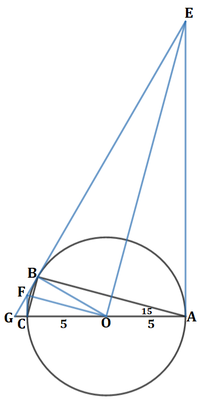Circumcircle and Tangents
Let triangle A B C be a right triangle such that its hypotenuse A C has length 1 0 and ∠ B A C = 1 5 ° . Let O be the center of the circumcircle of triangle A B C . Let E and F be the point of intersection of the lines tangent to the circumcircle at points A and B and points B and C , respectively. Find the area of triangle O E F .
The answer is 50.
This section requires Javascript.
You are seeing this because something didn't load right. We suggest you, (a) try
refreshing the page, (b) enabling javascript if it is disabled on your browser and,
finally, (c)
loading the
non-javascript version of this page
. We're sorry about the hassle.
2 solutions

Since △ A B C is a right triangle, the circumcenter O is at the midpoint of C A , so that the radius is C O = O A = O B = 5 .
△ O B A is an isosceles triangle, so if ∠ B A C = 1 5 ° then ∠ O B A = 1 5 ° , which means ∠ B O A = 1 8 0 ° − 1 5 ° − 1 5 ° = 1 5 0 ° .
Since ∠ O B E = ∠ O A E = 9 0 ° , O B E A is a cyclical quadrilateral, which means ∠ B E A = 1 8 0 ° − ∠ B O A = 1 8 0 ° − 1 5 0 ° = 3 0 ° .
By alternate interior angles of parallel segments F C ∣ ∣ E A , ∠ G F C = ∠ B E A = 3 0 ° .
Since ∠ G F C = ∠ B E A = 3 0 ° , G F = 2 G C and G E = 2 G A .
Since G E = G F + F E and G A = G C + C A , by substitution, G E = 2 G C + F E = 2 G A = 2 G C + 2 C A , so that F E = 2 C A = 2 ⋅ 1 0 = 2 0 .
Therefore, △ O E F has a base of F E = 2 0 and a height of O B = 5 , so its area is 2 1 ⋅ 2 0 ⋅ 5 = 5 0 .
By the alternate segment theorem , all the angles having the same color are equal to each other. Also,
A B = 1 0 cos ( 1 2 π ) , B C = 1 0 sin ( 1 2 π )
Using the law of sines we have -
B F = sin ( 6 5 π ) B C ⋅ sin ( 1 2 π ) , B E = sin ( 6 π ) A B ⋅ sin ( 1 2 5 π )
Since O B = 5 , substituting in values we get [ △ O E F ] = [ △ O F B ] + [ △ O E B ] = 2 5 ( B F + B E ) = 2 5 ( sin ( 6 5 π ) 1 0 sin 2 ( 1 2 π ) + sin ( 6 π ) 1 0 cos ( 1 2 π ) ⋅ sin ( 1 2 5 π ) ) = 5 0